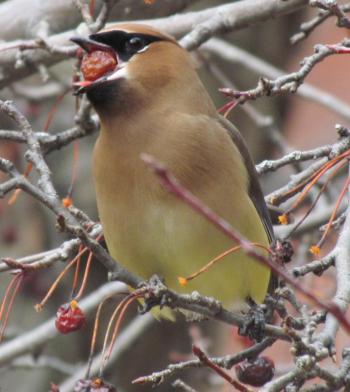What do yurts and waxwings have in common?
Cedar waxwings are being seen across the southern half of the state in decent numbers, sometime with significant numbers of their larger northern cousins, Bohemian waxwings. Whenever we see waxwings we can’t help thinking of yurts. A yurt is a round, tent-like structure that was commonly used by Mongolian nomadic herders. When we were graduate students at Cornell University there were a couple of semi-permanent yurts near the Cornell Lab of Ornithology that grad students lived in, at least in part because they were very inexpensive compared to a traditional apartment. One of our fellow grad students who lived in one of those yurts was a fellow named Mark Witmer who was studying cedar waxwings, especially their feeding and nutritional ecology. Back in those days, if you ran into Mark somewhere, your conversation quickly became focused on waxwing digestion. Mark is still one of the world experts on waxwings.
Waxwings are very unique in the bird world. To start, there are only three species in the waxwing family worldwide, and two of them can be found here in Maine in the winter. Waxwings eat the way many a school kid might without supervision, opting for nothing but sugary foods much of the year. In the winter in our area waxwings can go months subsisting on a diet of dried, sugary fruits, especially crabapples. Waxwings are able to process the sugars in fruits with high efficiency and even have the capacity to process some kinds of sugars that other birds are not able to process. But to get enough nutrition, they usually have to eat lots of fruits. That’s why when a flock descends on a crabapple tree, a free-for-all ensues that can quickly leave the tree bare. In the late winter and early spring before new fruits or other food sources appear, cedar waxwings are one of the few birds that will eat the red fruits of the ornamental European highbush cranberries. Mark discovered that the fruits of this shrub are highly acidic, which is probably why most birds avoid them. Even waxwings avoid them throughout most of the winter, but Mark found that in the spring, if the waxwings included catkins from early flowering trees to their diet then they could buffer the acidic effects and make the fruits more digestible.
Many fruits and berries contain compounds that keep some animals from consuming them because they are either toxic or unpleasant. Cedar waxwings have been found to have no problem consuming some of the compounds that other birds can’t. Because they consume so many different kinds of berries and fruits and then fly off to digest them and excrete the seeds in some other location, waxwings have a critically important ecological role as seed dispersers.
When flowers start reappearing in May, cedar waxwings have the charming habit of not only eating flowers themselves but sometimes sharing them with a prospective mate. We have often seen them eating the large, fleshy petals of apple blossoms. When insects begin hatching in the late spring and summer, waxwings do add protein to the diet by fluttering out from a tree or bush and snapping a flying insect out of the air. But even in summer, they also seek out whatever fruit is available.
Next time you bite into an apple or enjoy a blueberry, think of a waxwing…or a yurt.





























.png)
.png)

